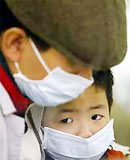Patients with H5N1 influenza exhibit basic symptoms similar to those of other types of influenza. However, the illness usually progresses rapidly, often leading to severe pneumonia, multiple organ failure, and death.
Common symptoms of influenza include: fever,
|
|
|
To prevent influenza, limit contact with infected sources by wearing masks in outbreak areas. |
fatigue, body aches, headaches, muscle and joint pain, weakness in limbs, dry and hot skin, watery eyes, runny nose, nasal congestion, sore throat, sometimes chest tightness, bitter mouth, nausea… Afterward, the temperature gradually decreases, can drop quickly to normal, and then spike again within a day, referred to as “V-shaped fever.” General symptoms subside within 5-7 days. Many patients do not have a fever, only sneezing, runny nose, and cough. However, there are also severe cases due to respiratory, cardiovascular, or neurological complications.
H5N1 influenza also presents the aforementioned symptoms, but they are usually more severe and progress very quickly. Patients may experience a dry cough, chest pain, difficulty breathing, and cyanosis due to pneumonia. Infected individuals may suffer from septic shock, multiple organ failure, and death. However, recently, some individuals infected with H5N1 influenza have exhibited mild, atypical symptoms. Therefore, it is essential to seek medical attention if symptoms such as fever, cough, difficulty breathing, muscle pain, or sore throat arise.
4 Preventive Measures Against Avian Influenza
Personal hygiene and food safety: Wash your face, nose, hands, and feet at least 2-3 times a day. Use upper respiratory antiseptics for nasal drops and gargling 2-3 times a day. Ensure food safety by avoiding consumption of poultry meat that is sick or suspected to be sick.
Limit contact with infected sources: When in contact with infected sources, proper protective equipment is necessary, including masks, gowns, gloves, and hats… produced according to technical standards to prevent virus entry. However, if such equipment is unavailable, simpler alternatives can be used.
Regularly clean the environment: Disinfect poultry farms affected by outbreaks, spray chloramine B around living areas, and even within households. After exiting outbreak areas, healthcare workers should remove protective gear and clothing (place them in sealed plastic bags, soak in disinfectant solutions, and take them to healthcare facilities for disposal).
Families in outbreak areas or with relatives infected with H5N1 should also clean their homes. Patients’ belongings should be soaked in disinfectant solutions for 20 minutes, then washed and dried.
Strengthen health through nutrition and exercise.
Seek immediate medical attention for symptoms such as high fever, headaches, muscle pain, sore throat, and cough.
Current antiviral medications for influenza include amantadine and rimantadine (which are older drugs that have developed resistance), as well as Tamiflu and Relenza. Among these, Tamiflu is an effective antiviral medication for treating H5N1 influenza. However, it is most effective when taken early within the first few days after infection. Usage of this medication should follow a doctor’s prescription.


















































